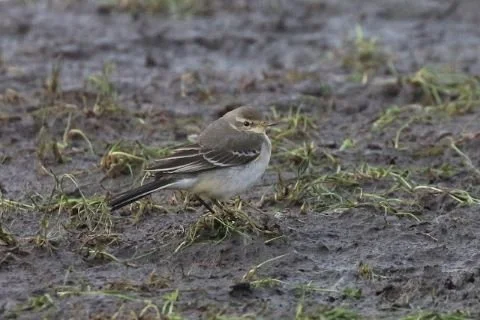Eastern Yellow Wagtail
Motacilla tschutschensis Gmelin, JF, 1789 (1, 0)
Photo © Rob Stonehouse - Prestwick Carr, Northumberland, 2 June 2019
STATUS
Eurasia and North America. Polytypic.
OVERVIEW
J. M. Collinson, S. Waite & R. Y. McGowan (2013) in a short paper gave the results of DNA analysis on the two specimens from early in the 20th century and one from Devon in 2010, also of this group.
RECORD
1). 1909 Fair Isle No locality, first-winter female, collected, 9th October, now at National Museums of Scotland (NMSZ 1910.132.15).
(K. Williamson & I. J. Ferguson-Lees, British Birds 48: 360; K. Williamson, British Birds 48: 400; Forrester & Andrews et al., 2007; J. M. Collinson, S. Waite & R. Y. McGowan, British Birds 106: 36-41, plates 36-38).
History K. Williamson & I. J. Ferguson-Lees (1955) in British Birds, Vol. XLVIII. p. 360, say: 'There are in the Royal Scottish Museum two 1st-winter wagtails collected by Dr. W. Eagle Clarke at Fair Isle and labelled "identification uncertain". These birds, strictly on the basis of a taxonomic comparison, are M. f. simillima. They match perfectly 15 first-winter specimens of this race in the National Collection (including one from Kamchatka and 4 from Pegu, Burma), having the characteristics of yellow axillaries, under tail-coverts and angle of wing, and lacking the buff forehead and the clean contrast of pure white markings on the blackish-brown wing-feathers. The data with these birds are: female, 9.x.1909, wing 80, tail 70 mm. (regd. no. 1910.132.15); male, 25.ix.1912, wing 77, tail 69mm. (regd. no. 1913.50.20). A first-winter male dated 4.xi.1908 (regd. no. 1909.126.10) may also be this race, but is rather less typical though nearer to that form than to western thunbergi.'
K. Williamson (1955) in British Birds, Vol. XLVIII. p. 400, says: 'Very rare vagrant in autumn, Fair Isle (Williamson and Ferguson-Lees, 1955). The occurrence at Fair Isle of two 1st-winter birds which match this race perfectly, female 9th October 1909 and male 25th September 1912, and a male 4th November 1908 which is near to this form, is very remarkable; it is possible they reached western Europe by drift in the polar east-wind belt, as happens with east Siberian species in some years.'
J. M. Collinson, S. Waite & R. Y. McGowan (2013) in British Birds, Vol. CVI. pp. 36-41, say: 'DNA evidence has showed that this specimen is from the north-eastern taxa (tschutschensis or plexa).'
NOT PROVEN
0). 1912 Fair Isle No locality, first-winter male, collected, 25th September, now at National Museums of Scotland (NMSZ 1913.50.20).
(K. Williamson & I. J. Ferguson-Lees, British Birds 48: 360; K. Williamson, British Birds 48: 400).
[J. M. Collinson, S. Waite & R. Y. McGowan, British Birds 106: 36-41, plates 439-41].
History DNA has proved it belongs to the Western Yellow Wagtail group.
